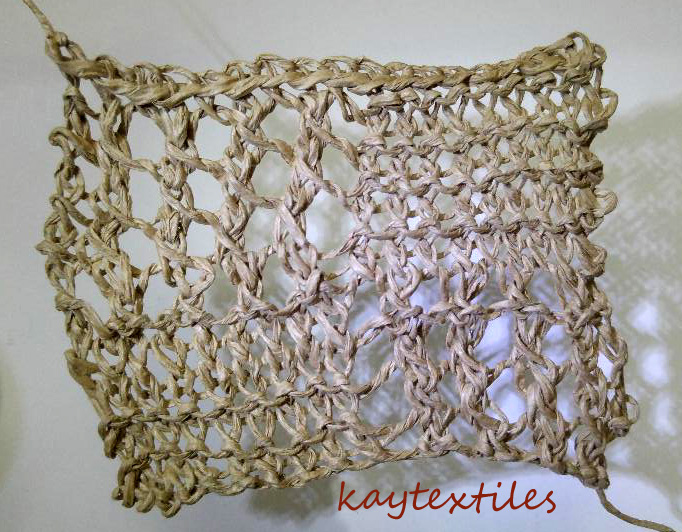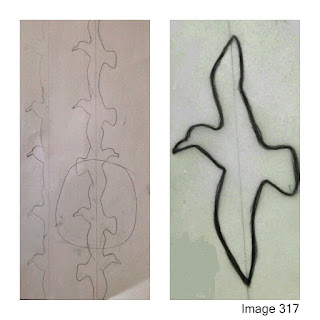To try to be sympathetic with my theme of 'gulls with an emphasis on shadow', I decided to use rug canvas (large grid) as a starting point onto which I attached builders' scrim (smaller grid). This I hoped would give me a mesh that the light would go through. Initally I tried attaching the scrim with dilute PVA but all I ended up with was a sticky mess and little adhesion. I then sampled the somewhat limited stitch patterns on my trusty Bernina 1015 Sport in order to attach the scrim with a stitch pattern that would replicate the impression of feathers (Image 315).
I decided on Pattern 13, length 4, varying the width from 5 to 3 (3 being used to fill in some areas to give variety). This enabled me to attach the scrim.
STAGE 2 - Colour background
I coated both sides of the background with emulsion and then coloured it with acrylic in the style of Image 292 (Image 316).
STAGE 3 - Add detail and pattern with stitching
I had already done this in Stage 1 prior to colouring and wanted to leave the edges raw when cut, rather than stitched as I felt this would be more sympatheic to my design.
STAGE 4 - Cut up into separate shapes
Rather than using individual shapes, which I had already done in previous designs (Image 56 in particular), I decided on the continuous line option to give me strips.
Rather than going ahead and cutting into the background I had created I sampled different lines on paper using the gull outline. I liked the circled shape in Image 317.
I created a cardboard template based on this design (Image 318 - middle section) and cut out the strips from the background already created.
STAGE 5 - Arrange shapes in interesting compositions
In the black and white Image 318 interesting design possibilities from this linear design are clear when the shapes run parallel, perhaps replicating the shape in simple stitch marks onto whatever lies below. Crossing lines are not used in my designs as they disrupt the flow.
Image 319 - strips staggered
Image 320 - strips repositioned and staggered
Image 321 - strips placed on top of digital design from container ship on Welland Canal.
Image 322 and 322A - strips placed to frame details on image below (looking out to sea from Turner Contemporary, Margate on visit to Entangled exhibition).
Image 323 - strips fanning out.
STAGE 6 - Make a proposal for a resolved embroidered item
I propose to make a fan as my functional three-dimensional piece as it will enable me to use the gull shape and, due to the nature of the fan and its ability to allow light through the structure, will facilitate the production of shadows from these shapes, something not possible with many other items. Though a fan is functional, I would anticipate static presentation alongside a suitable light source. The following pages are from my sketchbook (A3 size).
Image 324 - Proposal to make a Gull Fan...the must-have costume accessory for a day at the seaside. (Things will get less frivolous.)
Consideration was then given to the type of fan I might make.
Image 325 - a fixed fan with either a separate or fixed handle. Though I could place any of my previous design ideas in a chosen fixed shape, this felt rather like putting a panel on a stick and there would not be much scope for construction or three-dimensional exploration, so I'd probably not go for this option.
Image 326 - folding fans, either pleated or brisé.
Image 327 - cockade - pleated example shown though this type could also be brisé. The circular form of this type of fan didn't appeal to me as I felt it wasn't sympathetic to my topic.
So I decided to go for a folding brisé fan as instead of a pleated leaf placed over sticks it has separate sticks held together at the top by some sort of cord and at the base in some way to allow it to pivot. My choice was partly due to the design possibilities I could see Image 323 providing. The two outer sticks (guards) could also be more ornamental than the others.
I revisited Image 323 and where it might lead. This has been done in black and white to make the design elements more pronounced.
Image 328 - opening out the sticks. Though I like where the first set of birds open out from above the pivot, more work would need to be done on the shadows this is producing. Also, consideration would have to be given to the tops (and bottoms) of the sticks and how the fan looks when closed - something to think about in all the designs given below.
Image 329 - this is where I think things start to get interesting. Is you take the negative images around the bird string and use it, there are endless shadow possibilities depending on how much the the fan is opened. This is based on the birds alternating on the string in the direction in which they face. I think this is probably a bit busy and it might be simpler if the birds all faced the same way.
Image 330 - bird string where all the gulls face in the same direction.
Image 331 - birds facing same direction fanning out. Not so successful as they overlap one another near the pivot.
Image 332 - birds facing same direction but staggered placement - better.
Image 333- birds facing same direction using negative images - fanning out...
Image 334 - as Image 333, but fanning out more.
Image 333 and 334 so far appeal to me the most. I like the fact that when the fan is closed you will have no idea what will be revealed when it is opened. There is a lot more work to do on this but I think it has possibilities. One tweak would be to have the sticks more the shape of a thin slice of cake, tapering to the pivot end, than with parallel sides and to adjust the design to fit.
Revisiting my Design Recipe:
- woven textures could be built into 'fabric' of which it is constructed (as shown in Image 315, though this is just one example)
- shadows - the placement of the design on the sticks will produce the shadows
- layers - again this could be built into the 'fabric'
- fluidity, curves, waves - this might be helped by wavy lines instead of straight lines enclosing the negative images
- movement - produced by the stitching on the 'fabric' (and you do wave a fan around!)
- ripped/cut edges - again the structure of the 'fabric'
- neutral palette - choice of colours
- startling rightness - I'll leave that one up to you...I'm not sure it's there...yet...






















No comments:
Post a Comment